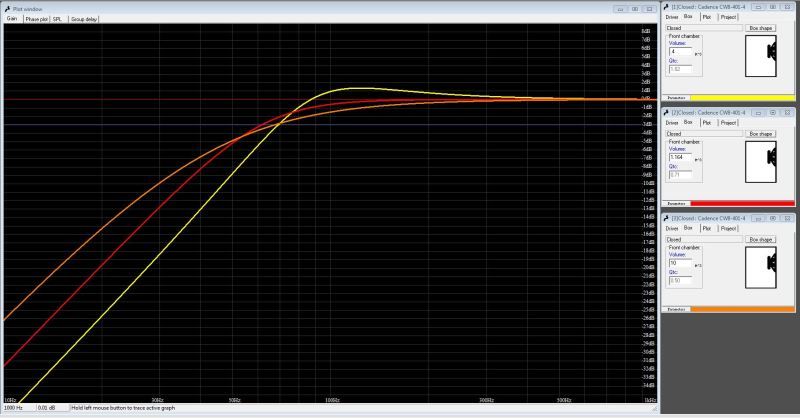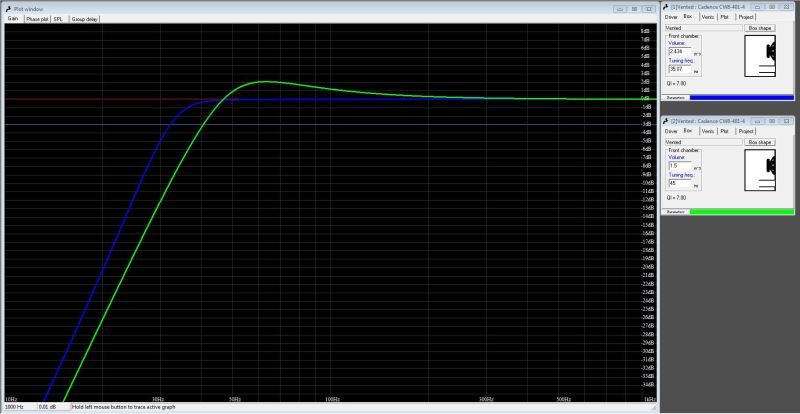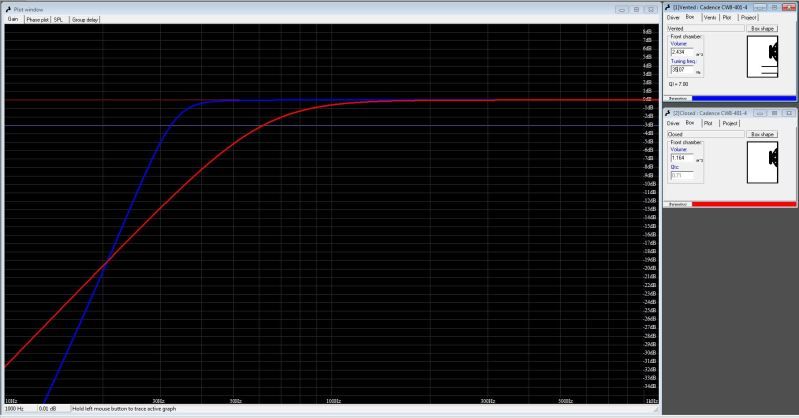Why do I think ported boxes are better than sealed? Well sealed has a very important role in mobile audio, and the biggest is they take up the least amount of space, its next to impossible to make a bad one (either too small or has holes, thats about all you can do wrong), and they provide very accurate bass response. What I dont like about sealed is the poor low freq reproduction, and they pretty much rely on the cabin gain to make that low end audible. What am I talking about? Well lets take a look

This is essentially a random 8" sub modeled across 3 sealed boxes, which is to show how this sub should perform in such box sizes.
The Yellow line represents a 0.4cuft sealed box, the red represents an ideal sized 1.164cuft sealed box, and the orange represents a 10cuft sealed box.
These graphs do not account for any cabin gain, which is completely different from car to car and even shifts day to day based on climate, temps, humidity, etc..... So I will ignore that for now.
Starting with the yellow (typical "tight fit" enclosure), look at that ugly boost at 100hz. This sub would have to be crossed over at 80~90hz to keep it reasonable sounding, but then look at how fast that bass drops off. At 50hz it is -9db, and at 30hz its -19db!
The Red is a little better in some spots, and worse in others. The roll off is consistant, but it is NOT flat. 90hz is -1db (1 lower than yellow, inaudible difference), is only -3db at 50hz (6db louder than yellow = twice the volume level), and then -10db at 30hz (9db louder than yellow, big difference). That red line looks a lot better than the yellow for only a difference of ~.7cuft.
Looking at the orange we see it is a little quieter up top and a little louder down low, this is more like a freeair setup than a sealed box and shows a much smoother roll off. (& why freeair setups can be very popular)
So what if we look at a ported box? Now that we understand how a sealed box should perform, lets look at the typical ported setup, assuming we have the space to even consider one.

This is the same woofer as in the sealed tests, to keep things pretty close to fair. The green line represents a common prefab ported box, and similar to what many manufacturers list as a "recommended" or high output (SPL) oriented ported enclosure. This is a 1.5cuft box with a port tuned to 45hz.
The blue line represents a setup I would work toward, and most people seeking sound quality before quantity. (not a pure SQ box, more what people would refer to as a "SQL" box) It is a 2.4cuft box tuned to 35hz.
Lets compare these, starting with the (ugh) prefab box in green.
This is what often gives ported boxes such a bad name, this response gives tons of output over a very narrow band of frequencies with a sharp roll off way too early, easily becoming a "1 note wonder" box. Musically this is just bad, but if all you want is bass this is HUGE with gains easily 6+db over the sealed (to our ears that would be double the output). The low end bass falls off too early to enjoy any bass below 40hz, and even though its 30hz level is only a single db below the ideal sealed enclosure (-10db vs -9db), when compared to the overboosted mid range bass the 30hz will seem almost non-existent.
So lets look at the blue graph now, and one that I would consider a flat response.
This bass response stays true to equal volume completely down to 45hz, and then falls right off. 30hz is only -5db, that is7db louder than the SPL box without the ugly hump. 20hz drops off pretty sharply, and to keep this sub from unloading a subsonic around 25~30hz would be great, the SPL box would need a much higher subsonic probably around 35~40hz to keep it from killing itself, considering lots of music plays around 30~40hz.
Now lets compare directly the ideal sealed to the ideal ported.

Look at the difference between these two, the ported is 2db louder at 70hz, 3db louder at 60hz, 5db louder at 50hz, 7db louder at 40hz, and 8db louder at 30hz! (20hz is the same level). The ported box produces bass from basically 45hz and up at the exact same level, how can anyone consider that to be a bad thing?
You could use an EQ and boost the lower signals of a sealed box to mimic this curve, however with the boosted equalization distortion can be increased, power consumption is increased, and the accuracy of the bass drops, making the sealed just as "sloppy" as a ported setup. More info on this topic here by people smarter than I.
What about the classic "dual woofers sealed vs single ported" debate? Well, for a sealed setup to make up that 8db difference at 30hz without EQ, you would need almost 8 times the output. (x2 for 3db, x4 for 6db, x8 for 9db) And what happens when you add subs/power everything gets louder, which you really dont want or even need from around 60hz & up. That also assumes that when you add another woofer (or woofers) the airspace increases too, because if you throw two subs in the same 1.16cuft ideal sealed box above it starts to look a LOT more like that yellow graph than the orange graph, which is no good either.
Now lets open up this discussion


